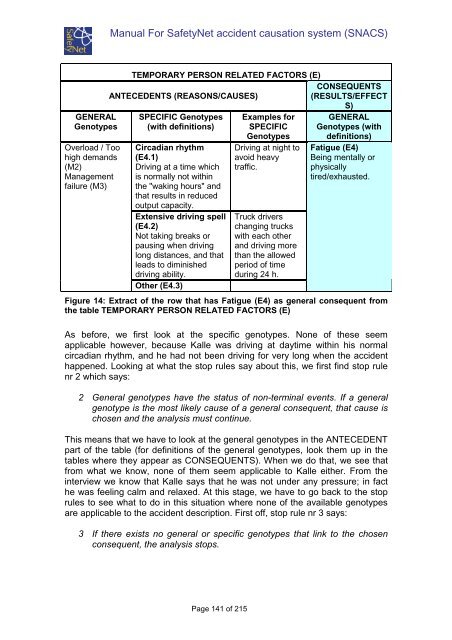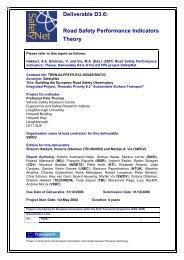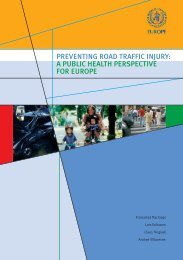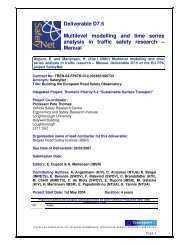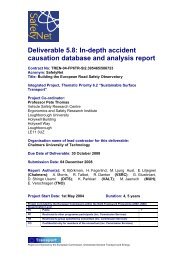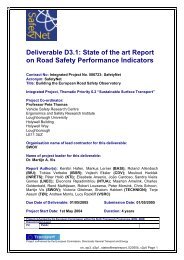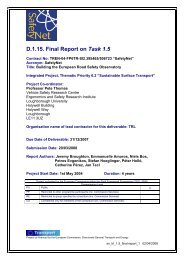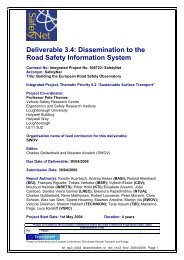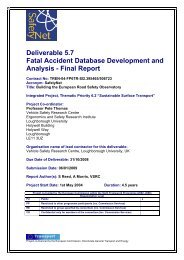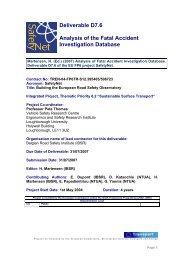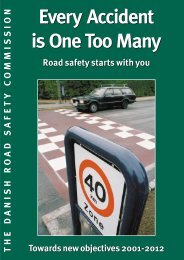Glossary of Data Variables for Fatal and accident causation ... - ERSO
Glossary of Data Variables for Fatal and accident causation ... - ERSO
Glossary of Data Variables for Fatal and accident causation ... - ERSO
Create successful ePaper yourself
Turn your PDF publications into a flip-book with our unique Google optimized e-Paper software.
Manual For SafetyNet <strong>accident</strong> <strong>causation</strong> system (SNACS)<br />
TEMPORARY P<strong>ERSO</strong>N RELATED FACTORS (E)<br />
CONSEQUENTS<br />
ANTECEDENTS (REASONS/CAUSES)<br />
(RESULTS/EFFECT<br />
S)<br />
GENERAL<br />
Genotypes<br />
SPECIFIC Genotypes<br />
(with definitions)<br />
Examples <strong>for</strong><br />
SPECIFIC<br />
Genotypes<br />
GENERAL<br />
Genotypes (with<br />
definitions)<br />
Overload / Too<br />
high dem<strong>and</strong>s<br />
(M2)<br />
Management<br />
failure (M3)<br />
Circadian rhythm<br />
(E4.1)<br />
Driving at a time which<br />
is normally not within<br />
the "waking hours" <strong>and</strong><br />
that results in reduced<br />
output capacity.<br />
Extensive driving spell<br />
(E4.2)<br />
Not taking breaks or<br />
pausing when driving<br />
long distances, <strong>and</strong> that<br />
leads to diminished<br />
driving ability.<br />
Other (E4.3)<br />
Driving at night to<br />
avoid heavy<br />
traffic.<br />
Truck drivers<br />
changing trucks<br />
with each other<br />
<strong>and</strong> driving more<br />
than the allowed<br />
period <strong>of</strong> time<br />
during 24 h.<br />
Fatigue (E4)<br />
Being mentally or<br />
physically<br />
tired/exhausted.<br />
Figure 14: Extract <strong>of</strong> the row that has Fatigue (E4) as general consequent from<br />
the table TEMPORARY P<strong>ERSO</strong>N RELATED FACTORS (E)<br />
As be<strong>for</strong>e, we first look at the specific genotypes. None <strong>of</strong> these seem<br />
applicable however, because Kalle was driving at daytime within his normal<br />
circadian rhythm, <strong>and</strong> he had not been driving <strong>for</strong> very long when the <strong>accident</strong><br />
happened. Looking at what the stop rules say about this, we first find stop rule<br />
nr 2 which says:<br />
2 General genotypes have the status <strong>of</strong> non-terminal events. If a general<br />
genotype is the most likely cause <strong>of</strong> a general consequent, that cause is<br />
chosen <strong>and</strong> the analysis must continue.<br />
This means that we have to look at the general genotypes in the ANTECEDENT<br />
part <strong>of</strong> the table (<strong>for</strong> definitions <strong>of</strong> the general genotypes, look them up in the<br />
tables where they appear as CONSEQUENTS). When we do that, we see that<br />
from what we know, none <strong>of</strong> them seem applicable to Kalle either. From the<br />
interview we know that Kalle says that he was not under any pressure; in fact<br />
he was feeling calm <strong>and</strong> relaxed. At this stage, we have to go back to the stop<br />
rules to see what to do in this situation where none <strong>of</strong> the available genotypes<br />
are applicable to the <strong>accident</strong> description. First <strong>of</strong>f, stop rule nr 3 says:<br />
3 If there exists no general or specific genotypes that link to the chosen<br />
consequent, the analysis stops.<br />
Page 141 <strong>of</strong> 215


